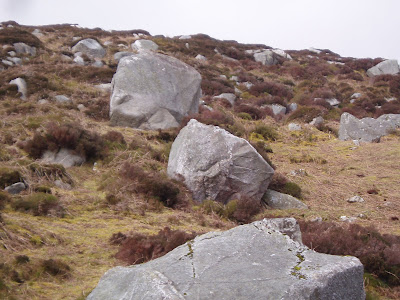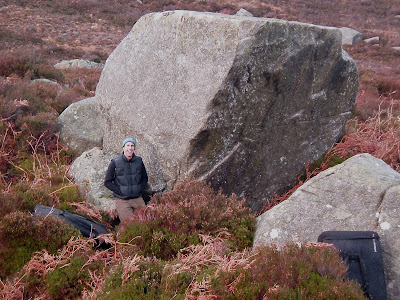The Stonecutters Glen is the real name of that not so secret Area 52. And since it is not that secret anymore, here is a bit of information on what is there. Please note that the following is just an outline and I will prepare a more detailed information for the update of Dave Flanagan’s Bouldering guide to Ireland in the next few days.
ACCESS
 Park at the same carpark than Lough Bray, two kilometres south of Glencree on the military road beside the small quarry. Go up to the top of the small quarry and walk through the bog toward the Sugarloaf. Lough Bray should be in your back and Glencree on your left. After 20mn you will reach the Stonecutters Glen. The first main boulders you should come across are the egg and the split boulder.
Park at the same carpark than Lough Bray, two kilometres south of Glencree on the military road beside the small quarry. Go up to the top of the small quarry and walk through the bog toward the Sugarloaf. Lough Bray should be in your back and Glencree on your left. After 20mn you will reach the Stonecutters Glen. The first main boulders you should come across are the egg and the split boulder.
EGG BOULDER
 The Egg is the first big boulder you should come across. It has a very recognisable roundish blank slab (project) and a nice problem on its north side (right side on picture) involving a tricky top out on a round top: The egg. On the smaller boulder below is good sit-start deapoint that takes a few tries to adjust: Bloody clawmarks.
The Egg is the first big boulder you should come across. It has a very recognisable roundish blank slab (project) and a nice problem on its north side (right side on picture) involving a tricky top out on a round top: The egg. On the smaller boulder below is good sit-start deapoint that takes a few tries to adjust: Bloody clawmarks.
SPLIT BOULDER

Mickey’s traverse is still a project: it's the low traverse that follows the very round lip leftward from the corner jug. Warning: skin grater. Too little to late is the traverse that follows the top on the right.
ARETE
 Upper on the valley stand two nice boulders. There’s been blood is the excellent arete shown on the video. It involves finger jamming, dynamic slaping and a high enough finish. There's also an eliminate version using the arete only (project). The boulder below has two nice lines: Bert's rockover is the right hand side corner of the roundish slab. Gorillas in the mist is the right side of the arete. The start is reachy and definitly easier when you are tall.
Upper on the valley stand two nice boulders. There’s been blood is the excellent arete shown on the video. It involves finger jamming, dynamic slaping and a high enough finish. There's also an eliminate version using the arete only (project). The boulder below has two nice lines: Bert's rockover is the right hand side corner of the roundish slab. Gorillas in the mist is the right side of the arete. The start is reachy and definitly easier when you are tall.
THE STEM
 Brutal overhanging arête. Definitly the hardest line in the Stonecutters Glen. Rif Raf is the hard deadpoint from a crimpy rail on the right hand side.
Brutal overhanging arête. Definitly the hardest line in the Stonecutters Glen. Rif Raf is the hard deadpoint from a crimpy rail on the right hand side.
BIG SLAB
 The Big triangle slab at the top end of the valley is definitly worth a visit. The left hand side is Rock it : From the big bottom step rock over the arete to reach a good break higher and top out.
The Big triangle slab at the top end of the valley is definitly worth a visit. The left hand side is Rock it : From the big bottom step rock over the arete to reach a good break higher and top out.
Soledad is the excellent middle slab: Tricky start without footholds then up the various rails. The right hand side arete is much easier.
There is approximatly 25 lines developed in total. The lower part of the valley was not explored as it does not seem to be of much interest.
Text and Info by Pierre Fuentes
Dublin, March 2008.
ACCESS
 Park at the same carpark than Lough Bray, two kilometres south of Glencree on the military road beside the small quarry. Go up to the top of the small quarry and walk through the bog toward the Sugarloaf. Lough Bray should be in your back and Glencree on your left. After 20mn you will reach the Stonecutters Glen. The first main boulders you should come across are the egg and the split boulder.
Park at the same carpark than Lough Bray, two kilometres south of Glencree on the military road beside the small quarry. Go up to the top of the small quarry and walk through the bog toward the Sugarloaf. Lough Bray should be in your back and Glencree on your left. After 20mn you will reach the Stonecutters Glen. The first main boulders you should come across are the egg and the split boulder.EGG BOULDER
SPLIT BOULDER
Mickey’s traverse is still a project: it's the low traverse that follows the very round lip leftward from the corner jug. Warning: skin grater. Too little to late is the traverse that follows the top on the right.
ARETE
THE STEM
 Brutal overhanging arête. Definitly the hardest line in the Stonecutters Glen. Rif Raf is the hard deadpoint from a crimpy rail on the right hand side.
Brutal overhanging arête. Definitly the hardest line in the Stonecutters Glen. Rif Raf is the hard deadpoint from a crimpy rail on the right hand side. BIG SLAB
Soledad is the excellent middle slab: Tricky start without footholds then up the various rails. The right hand side arete is much easier.
There is approximatly 25 lines developed in total. The lower part of the valley was not explored as it does not seem to be of much interest.
Thanks to everyone involved in the cleaning:
Tim Chapman,
Mickey 'the Dude' Nicholson,
Bernie O’Rourke,
Dec Tormey
& Sean Walsh.
Tim Chapman,
Mickey 'the Dude' Nicholson,
Bernie O’Rourke,
Dec Tormey
& Sean Walsh.
Text and Info by Pierre Fuentes
Dublin, March 2008.